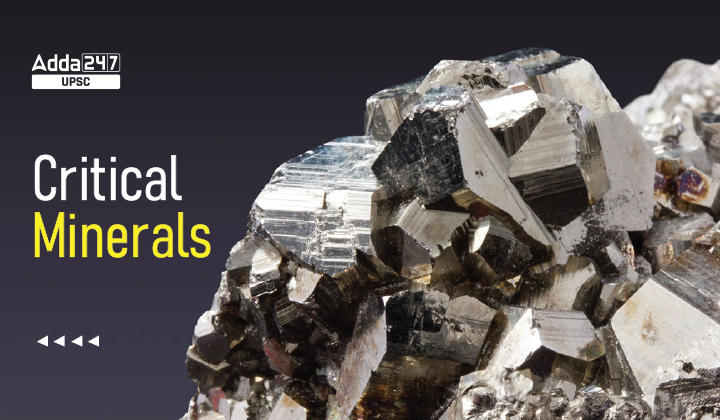Table of Contents
Critical Minerals: Relevance for UPSC Exam
General Studies III- Awareness In The Fields Of It, Space, Computers, Robotics, Nano-Technology, Bio-Technology, Pharma Sector & Health Science
Critical Minerals: Context
- Concerns over the pricing and availability of oil and gas in the wake of the Ukraine crisis continue to fuel global policy debates on energy security.
- Securing access to key critical minerals such as lithium, cobalt, nickel and rare earth metals is critical for building resilient and indigenous supply chains for clean energy technologies.
What are Critical Minerals?
- Critical minerals are elements that are the building blocks of essential modern-day technologies, and are at risk of supply chain disruptions.
- These minerals are now used everywhere from making mobile phones, computers to batteries, electric vehicles and green technologies like solar panels and wind turbines.
- Based on their individual needs and strategic considerations, different countries create their own lists though such lists mostly include graphite, lithium, cobalt and silicon which is a key mineral for making computer chips, solar panels and batteries.
Critical Condition
- As countries around the world scale up their transition towards clean energy and digital economy, these critical resources are key to the ecosystem that fuels this change.
- Any supply shock can severely imperil the economy and strategic autonomy of a country over-dependent on others to procure critical minerals but these supply risks exist due to rare availability, growing demand and complex processing value chain.
- Many times, the complex supply chain can be disrupted by hostile regimes, or due to politically unstable regions.
- They are critical as the world is fast shifting from a fossil fuel-intensive to a mineral-intensive energy system.
What are Rare Earth Metals?
- The rare earth elements (REE) are a set of seventeen metallic elements which includes the fifteen lanthanides on the periodic table plus Scandium and Yttrium.
- Rare earth elements are an essential part of many high-tech devices.
- They have a wide range of applications, especially high-tech consumer products, such as cellular telephones, computer hard drives, electric and hybrid vehicles, and flat-screen monitors and televisions.
- Significant defence applications include electronic displays, guidance systems, lasers, and radar and sonar systems.
- Rare earth minerals, with names like neodymium, praseodymium, and dysprosium, are crucial to the manufacture of magnets used in industries of the future, such as wind turbines and electric cars.
Critical minerals: Challenges in accessing
- Reserves are often concentrated in regions that are geopolitically sensitive or fare poorly from an ease of doing business perspective.
- A portion of existing production is controlled by geostrategic competitors. For example, China wields considerable influence in cobalt mining in the Democratic Republic of Congo through direct equity investments and its Belt and Road Initiative.
- Future mine production is often tied up in off take agreements, in advance, by buyers from other countries to cater to upcoming demand.
Critical minerals: Khanij Bidesh India Limited (KABIL)
- For sourcing of strategic minerals, the Indian government established Khanij Bidesh India Limited (KABIL) in 2019 with the mandate to secure mineral supply for the domestic market.
- A joint venture company namely Khanij Bidesh India Ltd. (KABIL) set up with the participation of three Central Public Sector Enterprises namely, National Aluminium Company Ltd. (NALCO), Hindustan Copper Ltd. (HCL) and Mineral Exploration Company Ltd. (MECL).
- The objective of constituting KABIL is to ensure a consistent supply of critical and strategic minerals to Indian domestic market. While KABIL would ensure mineral security of the Nation, it would also help in realizing the overall objective of import substitution.
Suggestions based on Council on Energy Environment and Water (CEEW) to achieve the objective of KABIL
- Figure out the mineral requirements of the domestic industry.
- Five-year road maps with clear targets for deployment and indigenous manufacturing across clean energy applications would provide visibility to domestic investors.
- Coordinate with the domestic industry to determine where strategic interventions by the government would be necessary for the purpose.
- KABIL could collaborate with industry to bolster its market intelligence capabilities for tracking global supply side developments.
- If conducive investment opportunities don’t exist KABIL should pre-emptively sign agreements with global mineral suppliers to secure future production. It could aggregate reliable supply of minerals for domestic requirements and sign back to back sales agreements with the domestic industry. Such large scale centralised national procurement could be done at preferential terms.
- The government should jointly invest in mining assets with geostrategic partners.
- KABIL should make equity investments in mining jurisdictions that private sector investors may deem too risky.
- Technologies such as sodium ion batteries could reduce requirements for sourcing minerals from beyond India’s borders.
- Develop policies on urban mining aimed at recycling mineral inputs from deployments that have completed their useful life. This could help in reducing the dependence on international sourcing.
Conclusion
Besides Ukraine, other potential geopolitical flash points also exist against a backdrop of dwindling multilateral cooperation. India must act immediately and decisively to mitigate these risks to its energy security.




 TSPSC Group 1 Question Paper 2024, Downl...
TSPSC Group 1 Question Paper 2024, Downl...
 TSPSC Group 1 Answer key 2024 Out, Downl...
TSPSC Group 1 Answer key 2024 Out, Downl...
 UPSC Prelims 2024 Question Paper, Downlo...
UPSC Prelims 2024 Question Paper, Downlo...




